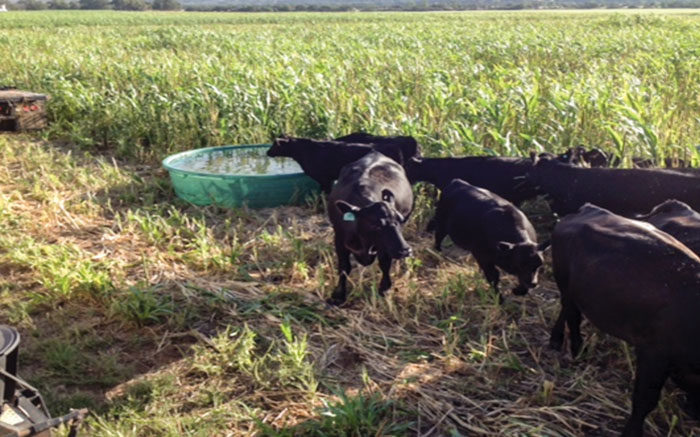No-Till Farmer
Get full access NOW to the most comprehensive, powerful and easy-to-use online resource for no-tillage practices. Just one good idea will pay for your subscription hundreds of times over.

TEACHABLE MOMENT. Angus-based commercial cattle grazing 39 days on a multi-species cover-crop mix the summer of 2015 changed no-tiller Jimmy Emmons’s thinking as it began rapidly improving his soil health and provided a healthy $115 per acre bonus between winter wheat crops. Emmons jokes about his “early mobile watering system” of poly tanks.
Northwestern Oklahoma no-tiller Jimmy Emmons quit plowing 10 years ago to begin rebuilding his soils and says by adding diverse cover crop mixes to his operation over the same period he’s cut his farm’s overall purchased fertilizer use by 85%.
In addition to reducing inputs, he’s also banking $100-150 per acre between small grain crops by following the combine in June with a multi-species warm-season cover crop mix for late-summer and early-fall grazing.
Emmons and his wife, Ginger, run a diversified farming and cow-calf operation near Leedey, Okla., about 40 miles south of the Oklahoma Panhandle and about 30 miles east of the Texas/Oklahoma line.
“In a semi-arid environment like ours, it’s more challenging to do cover crop systems but it’s our goal to have something growing on the land 365 days a year, if at all possible,” he explains.
A self-described “recovering tillage addict,” Emmons says his inspiration to adopt regenerative agricultural practices came at a National Association of Conservation Districts presentation by long-time Ohio no-tiller David Brandt.
NAME: Jimmy Emmons
LOCATION: Leedy, Okla.
ACRES: 2,000 no-till cropland; 6,000 rangeland
YEARS NO-TILLING: 10
CROPS: Wheat, rye, barley, grain sorghum, sesame, canola, peas, soybeans, corn, mung beans, triticale, sweet clover, oats, spring barley
ANNUAL PRECIPITATION: 25 inches
PRIMARY SOIL TYPE: Mollisol
IRRIGATION: Two center-pivot sprinklers along the river
LIVESTOCK: 250-300 cows
“He really inspired me with what we could do and how we could change our soils,” Emmons explains. “I grew up in a full tillage system…